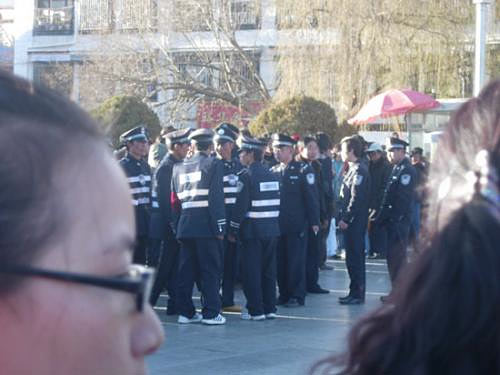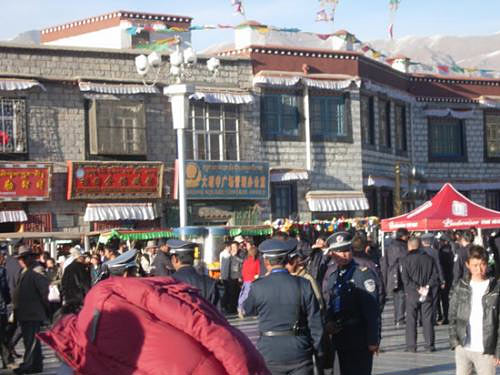
The tourists who witnessed the activity in the Jokhang Square on March 10 posted this image with the following caption: ‘This bunch of harmless looking policemen were just a distraction. The undercovers were the hard men, who were also watching us closely, so taking pictures of them was no option.’ (Source)
A crowd of several hundred monks were dispersed today in Lhasa by tear-gas after they protested the detention of Sera monks yesterday on the 49th anniversary of the major uprising against Chinese rule in Tibet, according to a report just released by Radio Free Asia. An eyewitness told RFA’s Tibetan service that a couple of thousand armed police and People’s Security Bureau personnel fired tear-gas at the crowd on a second day of protest in Lhasa.
The protests, unprecedented in recent years in Tibet’s capital, followed bold demonstrations yesterday by monks from Drepung and Sera monasteries on the 49th anniversary of the major uprising against Chinese rule in Lhasa. According to reports, the protests yesterday also involved as many as two or three hundred Drepung monks, while lay people formed a silent circle in an attempt to prevent the detentions of a small group of monks from Sera outside the Jokhang temple in central Lhasa.
The demonstrations are the largest by monks since the 1989 protests that led to the imposition of martial law in Tibet’s capital, and coincide with a march by Tibetan exiles through India to the Tibetan border in the buildup to the Beijing summer Olympics. They are likely to be of serious concern to Beijing, particularly following the peaceful ‘saffron protests’ by monks in Burma recently.
A new eyewitness report posted online by tourists of the incident yesterday in the Jokhang Square, in the centre of Lhasa, said that Tibetans “formed a strong, silent, peaceful circle around the police” after between seven and nine monks from Sera monastery shouted slogans outside the temple. The tourists, who posted their account on a blog, said that “hundreds” of Tibetans had formed a circle around the police, but that soon the police called for backup: “Undercover agents, not so difficult to recognize, film the whole happening. Especially the faces. This is one method to create fear. Suddenly there is panic. Six or seven monks are arrested and driven away. Tibetans are very scared because of the stories about the prisons and tortures. In the meanwhile big numbers of policemen arrive. They drive everybody apart.” (http://steve.ulrike.stivi.be/english/list.php?LijstNr=2&Item=55)
According to Radio Free Asia, as many as 300 monks set out from Drepung monastery outside Lhasa on the roughly 10-km (5-mile) walk into the city center yesterday (March 10). Security was already tight in Lhasa due to the significance of the 10 March anniversary, marking the uprising against Chinese rule that led to the escape of the Dalai Lama from Tibet in 1959. Around 50 to 60 monks were apparently detained at one of the checkpoints that leads into Lhasa. Witnesses reported seeing about 10 military vehicles, 10 police vehicles, and several ambulances at the checkpoint.
The whereabouts of the monks following all three protests is unknown although in answer to a press query today, Chairman of the Tibet Autonomous Region, Jampa Phuntsog, denied that any monks were still in custody following yesterday’s events. The report of demonstrations by Sera monks today by RFA indicates that the Sera monks who demonstrated in the Jokhang yesterday may still be in custody. Foreign Ministry spokesman Qin Gang said: “Yesterday afternoon in Lhasa city there were monks from some temples who, under the instigation and encouragement of a small group of people, carried out an illegal activity that threatened social stability.” (Associated Press report, March 11, 2008).
According to one source, the Drepung monks were reportedly calling for the release of Drepung monks who were detained last October following an incident in which monks celebrated the award of the Congressional Gold Medal to the Dalai Lama in Washington, DC, by whitewashing a room in the monastery. The same source said: “The demands were not political, it seems that the monks were being careful.” Another source said that the monks were also concerned about the issue of the lack of religious freedom in Tibet and at their monastery. According to the report by RFA today, the Sera monks protesting today shouted freedom slogans.
According to reports from inside Tibet, security was quickly stepped up even further at Drepung and Sera monasteries as well as in Lhasa itself, and hours after the detention of the monks, police closed one of the roads from Lhasa to Drepung, at the junction with Bayi Road and Beijing West Road, and vehicles were only allowed to head towards Lhasa. Reports of gunfire last night in the vicinity of Drepung monastery mentioned on a Tibetan blog by an authoritative source could not be confirmed today due to the severe restrictions on information flow imposed by the Chinese authorities and the atmosphere of fear in Lhasa.
The same account by a Tibetan reported that following the incident eyewitnesses saw: “Around ten army and police vehicles with sirens blaring and lights flashing [were seen] speeding in the direction of Drepung monastery. The vehicles had either army or police plates, and other vehicles had no plates. On the second ring road, seven army trucks with canvas awnings were speeding in the same direction behind another truck that had some concealed installation on it [which could have been a water cannon]. Around 10 minutes later, another seven similar trucks sped towards the western suburbs, but this second convoy was tailed by a “military ambulance”. At around 5:00 in the evening, the Lhasa Haiguan crossroads and all other roads leading to Drepung were closed by the army and several police were directing the traffic, some 20 of them, armed, with soldiers wearing packs spread out along the west side of the crossroads stopping all vehicles and pedestrians from passing.”
Several Tibetan blogs published yesterday on National Uprising Day included poems by Tibetans in Tibet lamenting “the dark period” and “the memory of past heroes”. A Tibetan in exile who studied the blogs said: “Their contents were not new, but messages were very clear”.
In India, several hundred Tibetan exiles have so far defied police orders in an attempt to march to Tibet from Dharamsala, home of the Dalai Lama, to the Tibetan border, in a protest against the Beijing Olympics. A Tibetan researcher who has been monitoring the protests inside and outside Tibet said: “People in Tibet have heard about the exiles’ march, and there seems to be something of a momentum linked to the international spotlight on China due to the Olympics.”

Public Security Bureau officers seen at the Jokhang Square in Lhasa on March 10, photographed by tourists. (Source)

